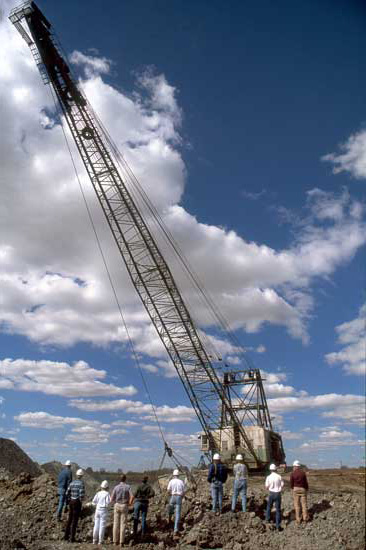| Kansas Geological Survey | Winter 1996 |
Vol. 2.1 |
| Hands-on Look at Energy Issues
CONTENTS Energy Issues–page 1 KGS on the World Wide Web–page 2 Excellence in Earth Science Education Award–page 3
|
We flip a light switch or pump gas, we expect energy. Using energy is easy, but dealing effectively with energy issues requires real, in-depth understanding of oil, natural gas, nuclear power, alternative energy, and related issues, from environmental concerns to economic impact. The Kansas Geological Survey's first field conference, a meeting held at various locations in east-central Kansas over three days in early October 1995, provided a hands-on look at energy, bringing together policy-makers—legislators, regulators, representatives of environmental groups, and teachers—to learn and talk about energy. At the La Cygne generating Station in Linn County, for example, participants saw and discussed coal-fired electrical generation. One generating unit at La Cygne burns a blend of about 15 percent local coal, from Missouri and Kansas, with Wyoming coal. La Cygne is the only power plant in the state equipped to burn Kansas coal, which is high in sulfur and produces lots of ash. Because of this reduced market, only one coal mine currently operates in Kansas—Clemens Coal Company's mine #22, near Arcadia in Crawford County, where participants watched coal being mined, cleaned and sorted. Coal mining, particulary strip mining, invariably raises environmental questions. Reclamation was discussed at stops in Crawford County where mined land had been recently reclaimed and at older mines that are candidates for reclamation. In southern Crawford County, the conference toured the site of a proposed electrical power plant that would use newly developed clean-coal technology to burn a combination of coal refuse, local coal, and petroleum coke. That led to conversations about the state's electrical capacity and the role of economics and regulation in constructing new electrical-generating facilities. For a first-hand look at oil production, the conference moved to the Burkett field, north of Eureka in Greenwood County. The Burkett typifies Kansas oil production—a mature field that pumped declining amounts of oil and increasing amounts of water. An independent operator with an aggressive program of well maintenance and new drilling, however, has increased recent production. Discussions at the Burkett focused on declines in Kansas oil and gas production and how best to deal with unplugged, abandoned wells that remain from decades of drilling. The El Dorado field, in Butler County, gave participants a different perspective on production. The El Dorado is a giant, having produced nearly 300 million barrels over its life. It's operated by a large company, OXY USA, Inc., which continues to drill additional wells to develop the field. There's more to energy use than production, however. Participants made a stop at El Dorado's Texaco refinery, then discussed transportation at Chase Pipeline Company and Groendyke Transport, a trucking compnay, both in El Dorado. Fossil fiels are the mainstay of Kansas energy production, but not the whole story. Charles F. Gay, director of the National Renewable Energy Laboratory in Golden, Colorado, updated the participants on developments in alternative energy, particularly the improved efficiency of soalr cells. The conference ended at the Wolf Creek Nuclear Generating Station in Coffey County with conversations about nuclear safety and the long-term storage of nuclear waste. Based on the suggestions of participants, the 1996 field conference, June 12-14, moves west to take on another equally important natural-resource issue facing Kansans: water. Understanding Energy and Energy Issues in Kansas, the 1995 Field Conference sponsored by the Kansas Geological Survey, was led by Robert S. Sawin. Participants included members of the Senate and House Energy and Natural Resources committees, representatives of the Kansas Department of Agriculture's Division of Water Resources, the Kansas Geological Society, the Kansas Corporation Commission, the Kansas Water Office, The Nature Conservancy, the Kansas Department of Health and Environment, and the Kansas Earth Science Teachers Association. The Survey would like to thank staff at Kansas City Power and Light, Clemens Coal Company, Kansas Department of Health and Environment, the El Dorado Chamber of Commerce, the Kansas Oil Museum, OXY USA, Texaco Refinery, Chase Pipeline Company, Groendyke Transport, Wolf Creek Generating Station, and Franklin Gaines and John Prather for their assistance. |
|
Coal mining equipment. |
 |
| Online February 10, 2003 Comments to: lbrosius@kgs.ku.edu Kansas Geological Survey URL:http://www.kgs.ku.edu/Publications/GeoRecord/1996/vol2.1/Page1.html |